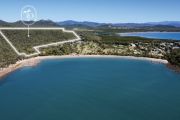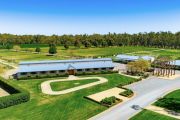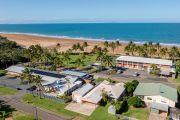
The Australian architect who pioneered green design in Singapore
If you’ve visited Singapore, there’s a good chance you’ve stayed in a hotel designed by Richard Hassell. The Perth-born architect is the co-founder of WOHA, established in 1994 with Wong Mun Summ, which has dotted the cityscape with residences and hospitality projects.
Hassell’s most recent project, the boutique hotel 21 Carpenter, is a rebirth of Singapore’s 1936 remittance office, with walls adorned with snippets of messages sent with money by homesick Chinese migrant workers. But the one that stands out the most for Hassell is the Parkroyal on Pickering.

The 367-room, mixed-use development pioneered a more sustainable building type in his adopted home, creating 15,000 square metres of greenery (double the site area), naturally ventilating corridors, harvesting rainwater and solar-powering irrigation.
Completed in 2013, a year before the acclaimed Bosco Verticale residential development in Milan, its cascading layers of garden showed density could be achieved in a way that made big buildings welcoming rather than alienating.
WOHA has since replicated the idea with other projects – such as the 23-storey Pan Pacific Orchard hotel on Claymore Road – but the Parkroyal defined the firm’s ethos as a designer of spaces that people wanted to live in; reflecting the realities of climate change rather than ignoring them. And, in the process, changing Singapore.

“We’ve had a good, virtuous-cycle relationship with the authorities in [incorporating greenery in building design],” Hassell says in his office in downtown Singapore, a space filled – unsurprisingly – with a forest of greenery that includes philodendrons, bird’s nest ferns and Australian wild violets. “As we’ve [incorporated greenery] in our projects, they’ve modified the regulations to make it possible, and then to make it compulsory.”
WOHA has now won Singapore’s top Design of the Year award 14 times, including this year for 21 Carpenter.
Born to a geologist-botanist father and microbiologist mother, Hassell – whose family has no link to the Australian design firm of the same name – graduated from the University of Western Australia with a degree in architecture in 1989.
He calls himself part of a “Perth mafia” of architecture graduates who emerged into a recession-hit market to find there were no jobs, forcing them to look further afield for work. Fortuitously, an aunt of his living in Singapore mentioned his name during a lunch with the wife of the now renowned resorts designer Kerry Hill. Also from Perth, he was based in the city state and had more work than his practice could handle. Within weeks Hassell had moved overseas.

“You’d better get on a plane right away because I need someone fast,” Hassell recalls the architect saying over the phone. “So I didn’t even have the chance to stay in Perth for Christmas after graduating. Then [Hill] went down to Perth for Christmas and left me doing the work.”
Five years later, he and Wong, a colleague at Kerry Hill Architects, struck out on their own. “Kerry was kind of hands-off, so we were managing our jobs, and we didn’t have many resources,” Hassell says.
But Hill taught them valuable lessons such as convincing clients how a project needed to be, rather than just doing what they wanted. “In Australia at that point, architects weren’t very well respected by the construction industry,” Hassell says. “Builders thought architects were wankers … this sort of overqualified person trying to get in the way of people who knew what they were doing.”
WOHA, with 100 people and 10 directors, is an “oversized, small practice” that does half of its work in Singapore and half internationally. Australia accounts for 10 to 20 per cent of its work, the sole one at present being Delta Australia’s 232-unit, mixed-use tower at 26 Cairns Street in Kangaroo Point, Brisbane.

So what’s it like to work in Singapore, which has just one layer of government – dominated by the People’s Action Party, which means it wields far more power to do what it wants than Australia’s fragmented, three tiers of government can achieve? Debates happen, but internally within the government, and then the rules are set.
While that makes development “frictionless and efficient”, it has a downside, Hassell says. “People have not had to establish their own values. There’s a bit of a culture of compliance. It’s like, ‘Oh, if it follows the rules, it’ll be approved. We don’t have to go above and beyond.’”
Hassell argues values play more of a role in Australian development, citing his work on a 47-storey residential tower at 443 Queen Street in Brisbane where the client Cbus Property insisted on good public space even though it didn’t have to. (The project, incidentally, triggered the collapse of contractor Probuild in 2022.)


“Australia does really well at public realm in inner cities, and there’s a real consensus in Australia that that’s important,” he says. “While in Singapore … [if] the government doesn’t require us to have a public space, we’re not going to provide a public space.”
There’s an extra level of risk to stepping outside the rules, too. Designers are personally liable for faults – such as a structure cracking – under Singapore’s so-called Qualified Person regime.
“It’s potentially jail terms and things like that,” Hassell says. “They legislatively made the buck stop with the person, not their firm. And so it does sharpen your attention to issues of quality and compliance.”
After 31 years, WOHA’s attention is now turning to teaching other architects, as well as focusing on master planning to ensure their ideas of green design are adopted at scale, Hassell says.


This is increasingly necessary as concrete and asphalt in metropolitan areas retain more heat than their rural surroundings.
“Every building has to have greenery for it to have an effect, otherwise cool air just blows down the street and gets diluted away,” he says. “It’s the same with air quality, pollution control – all those things are created by adoption at scale.”
And maybe they’re succeeding. “In many, many universities we visit, we think, all these look like WOHA buildings!” he laughs.
The writer visited Singapore as a guest of Singapore Design Week.











